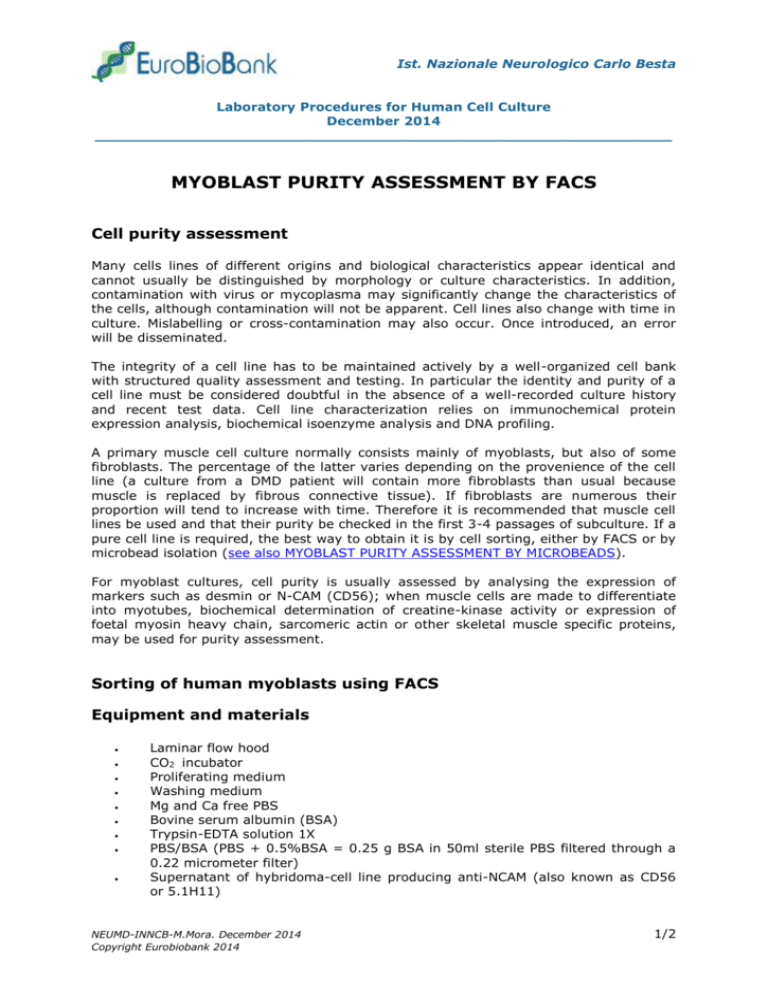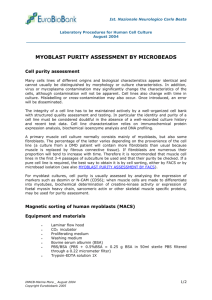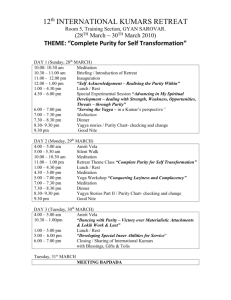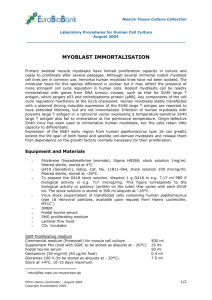Myoblast purity assessment by FACS
advertisement

Ist. Nazionale Neurologico Carlo Besta Laboratory Procedures for Human Cell Culture December 2014 _______________________________________________________________ MYOBLAST PURITY ASSESSMENT BY FACS Cell purity assessment Many cells lines of different origins and biological characteristics appear identical and cannot usually be distinguished by morphology or culture characteristics. In addition, contamination with virus or mycoplasma may significantly change the characteristics of the cells, although contamination will not be apparent. Cell lines also change with time in culture. Mislabelling or cross-contamination may also occur. Once introduced, an error will be disseminated. The integrity of a cell line has to be maintained actively by a well-organized cell bank with structured quality assessment and testing. In particular the identity and purity of a cell line must be considered doubtful in the absence of a well-recorded culture history and recent test data. Cell line characterization relies on immunochemical protein expression analysis, biochemical isoenzyme analysis and DNA profiling. A primary muscle cell culture normally consists mainly of myoblasts, but also of some fibroblasts. The percentage of the latter varies depending on the provenience of the cell line (a culture from a DMD patient will contain more fibroblasts than usual because muscle is replaced by fibrous connective tissue). If fibroblasts are numerous their proportion will tend to increase with time. Therefore it is recommended that muscle cell lines be used and that their purity be checked in the first 3-4 passages of subculture. If a pure cell line is required, the best way to obtain it is by cell sorting, either by FACS or by microbead isolation (see also MYOBLAST PURITY ASSESSMENT BY MICROBEADS). For myoblast cultures, cell purity is usually assessed by analysing the expression of markers such as desmin or N-CAM (CD56); when muscle cells are made to differentiate into myotubes, biochemical determination of creatine-kinase activity or expression of foetal myosin heavy chain, sarcomeric actin or other skeletal muscle specific proteins, may be used for purity assessment. Sorting of human myoblasts using FACS Equipment and materials Laminar flow hood CO2 incubator Proliferating medium Washing medium Mg and Ca free PBS Bovine serum albumin (BSA) Trypsin-EDTA solution 1X PBS/BSA (PBS + 0.5%BSA = 0.25 g BSA in 50ml sterile PBS filtered through a 0.22 micrometer filter) Supernatant of hybridoma-cell line producing anti-NCAM (also known as CD56 or 5.1H11) NEUMD-INNCB-M.Mora. December 2014 Copyright Eurobiobank 2014 1/2 Ist. Nazionale Neurologico Carlo Besta Myoblast purity assessment by FACS ______________________________________________________________ Biotinylated anti-mouse IgG secondary antibody Texas red-avidin or fluorescein-streptavidin Eppendorf tubes Microfuge Fluorescence-activated cell sorter (FACS) Procedure 1. Harvest cells with trypsin-EDTA, and wash twice in PBS containing 0.5% BSA with centrifugation for 2 min at 1500 rpm 2. Count cells (see ROUTINE CELL COUNTING AND ASSESSMENT OF VIABILITY). 3. Transfer cells to Eppendorf tubes and incubate at room temperature for 20 min in anti-NCAM supernatant, then for 20 min in biotinylated secondary anti-mouse IgG (7mg/ml), and finally for 20 min in Texas red-avidin or fluorescein-streptavidin (10 microg/ml). 4. Between each incubation wash cell three times in PBS/BSA with 15 second centrifugation at 15000 rpm in a microfuge. 5. To assess viability (facultative) during the 5 last min of the final incubation add propidium iodide (1 microg/ml final concentration). 6. Do a sterile sort of the cells by FACS following standard procedures taking care to correctly calibrate the fluorescence and light scatter channels. 7. Collect cells into proliferating medium, either in 96-well tissue culture plates (one cell per well for clonal propagation) or in 6 ml tubes for replating into Petri dishes (for polyclonal mass culture). Reference Webster C, Pavlath GK, Parks Dr, Walsh FS and Blau HM: Isolation of human myoblasts with the Fluorescence-Activated Cell Sorter. Exp. Cell Res. 1988; 174: 252-265. NEUMD-INNCB-M.Mora. December 2014 Copyright Eurobiobank 2014 2/2






